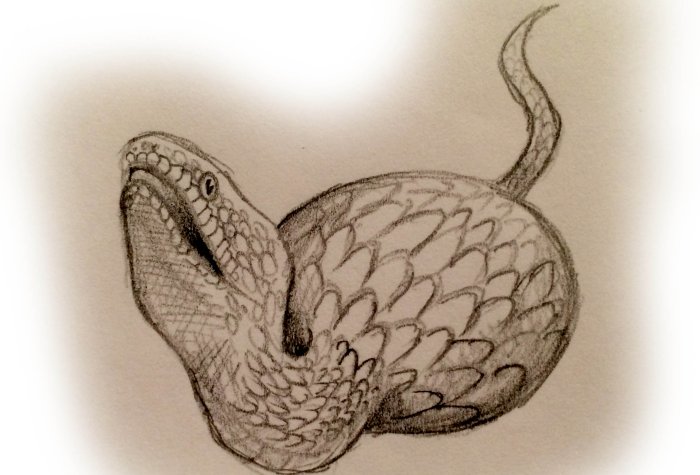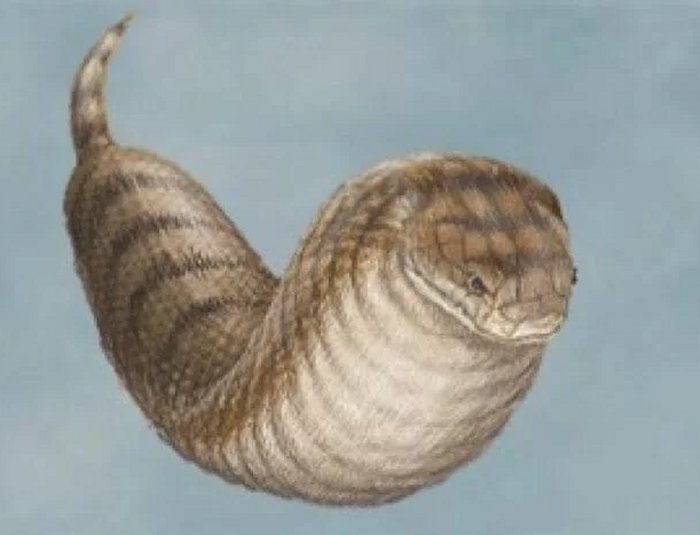Is The Legendary Tsuchinoko Real?
Ellen Lloyd - AncientPages.com - Tsuchinoko is a legendary ancient creature that appears in Japanese myths. Interestingly, people in modern times report having encountered the fearsome snake-like being. Does this mysterious creature exist only in the realm of mythology or could it be an unknown new species?
In Japanese mythology and folklore. Tsuchinoko is described as a creature having a think belly. The Japanese word for Tsuchinoko means “child of the hammer” or “child of dirt”.
Artistic depiction of the Tsuchinoko. Image credit: A Book of Creatures
In Northeastern Japan, the peculiar being is known as bachi hebi. Like many other mythological creatures, Tsuchinoko often displays supernatural abilities uncommon for animals we are familiar with. For example, despite its small size, being only between 30 and 80 centimeters (12 and 31 inches) in length, Tsuchinoko can jump very high up in the air. It often makes several jumps one after another.
This mysterious creature was “mentioned for the first time in the “Kojiki,” a text from the eighth century, which is Japan’s oldest existing chronicle and the oldest book written in Japanese.” 1
Japanese folklore stories tell the Tsuchinoko possesses the ability to speak and enjoy alcohol. It’s a creature that often lies and swallows its tail. In some ways, Tsuchinoko resembles the legendary American hoop snake. Tsuchinoko is said to inhabit deep, remote mountains and the animal’s color varies, but it’s mostly described as a black or dark brown creature having a thick orange belly.
Some years ago, an unusual reptile was discovered in Mikata a town located in Mikata District, Hyōgo, Japan. Its peculiar appearance brought the legend of Tsuchinoko alive again.
Since no one has ever found a real Tsuchinoko, it was difficult to determine if the unknown reptile was the same legendary snake mentioned in ancient Japanese tales. However, according to local government official Toshikazu Miyawaki, the animal found in Mikita might have been the Tsuchinoko. Its body was very thick and short. Several people also heard its squeak.
Is the Tsuchinoko an unknown new species? Image credit: hajime-no-ippo/Tumblr
It’s not the first time reports of Tsuchinoko reached the media.
In the opening years of the twenty-first century, there was another tsuchinoko boom, this one occurring when a farmer in a small town in Okayama Prefecture found the remains of a mysterious creature. The discovery set off a frenzy in the mass media, with tabloid newspapers, magazines, and television shows captured people's attention. Eventually, the body was examined by a biologist, who pronounced it “probably a yamakagashi [tiger keelback snake, Rhabdophis tigrinus] but not a normal one.”
The town itself had quickly become identified with the tsuchinoko (there had been earlier sightings as well), and today tsuchinoko is a local brand—you can, for example, buy tsuchinoko wine.” 2
Alleged sightings of Tsuchinoko keep pouring in, but this little creature remains as elusive as ever refusing to give up its identity and reveal its hiding place.
Modern scientists still discovered many previously unknown creatures. So, it’s very possible there is a snake-like animal somewhere that once gave rise to the Tsuchinoko legends, but researchers have just not been able to confirm its existence yet. Perhaps Tsuchinoko resides not in mountains but rather inhabits the deep underwater realm because it has evolved into a semi-aquatic animal.
One should not dismiss the possibility Tsuchinoko is a new species awaiting discovery. However, currently, it is still classified as a Yokai (“Yōkai”), a mysterious, supernatural creature mentioned in Japanese mythology.
Written by Ellen Lloyd – AncientPages.com
Copyright © AncientPages.com & Ellen Lloyd All rights reserved. This material may not be published, broadcast, rewritten or redistributed in whole or part without the express written permission of AncientPages.com and Ellen Lloyd
Expand for references- Moriguchi Kenzo - "Town touting mythical snake find; is 'rare' creature really a cash cow?". The Japan Times
- Michael Dylan Foster - The Book of Yokai: Mysterious Creatures of Japanese Folklore
More From Ancient Pages
-
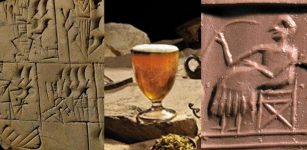 Ninkasi – Sumerian Goddess Of Beer And Alcohol – The Hymn To Ninkasi Is An Ancient Recipe For Brewing Beer
Featured Stories | Feb 27, 2019
Ninkasi – Sumerian Goddess Of Beer And Alcohol – The Hymn To Ninkasi Is An Ancient Recipe For Brewing Beer
Featured Stories | Feb 27, 2019 -
 Rare Medieval Chess Piece And Game Collection Unearthed At A Forgotten Castle
Archaeology | Jun 7, 2024
Rare Medieval Chess Piece And Game Collection Unearthed At A Forgotten Castle
Archaeology | Jun 7, 2024 -
 New Light On Foodways In The First Cities In Mesopotamia
Archaeology | Nov 21, 2022
New Light On Foodways In The First Cities In Mesopotamia
Archaeology | Nov 21, 2022 -
 On This Day In History: Mary Queen Of Scots Born – On December 8, 1542
News | Dec 8, 2016
On This Day In History: Mary Queen Of Scots Born – On December 8, 1542
News | Dec 8, 2016 -
 Diyu – Terrible Chinese Hell And Judgement Of God Yama
Chinese Mythology | Dec 18, 2018
Diyu – Terrible Chinese Hell And Judgement Of God Yama
Chinese Mythology | Dec 18, 2018 -
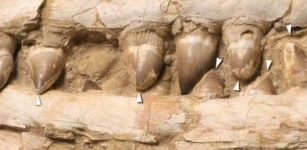 ‘Sea Monsters’ Were Real Millions Of Years Ago: New Fossils Tell About Their Rise And Fall
Featured Stories | Oct 8, 2022
‘Sea Monsters’ Were Real Millions Of Years Ago: New Fossils Tell About Their Rise And Fall
Featured Stories | Oct 8, 2022 -
 Unique Ancient Map Depicting The Earth As Seen From Space Restored Digitally
Archaeology | Dec 18, 2017
Unique Ancient Map Depicting The Earth As Seen From Space Restored Digitally
Archaeology | Dec 18, 2017 -
 Study Sheds Light On Life Beyond Rome’s Frontier
Archaeology | Jun 2, 2022
Study Sheds Light On Life Beyond Rome’s Frontier
Archaeology | Jun 2, 2022 -
 Sodré Astrolabe, Found On Portuguese Armada Shipwreck Is The Oldest In The World
Archaeology | Mar 19, 2019
Sodré Astrolabe, Found On Portuguese Armada Shipwreck Is The Oldest In The World
Archaeology | Mar 19, 2019 -
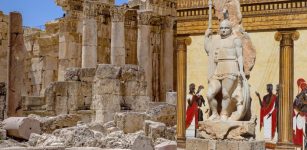 Did Lead Pollution Cause IQ Declines Among Ancient Romans?
Places | Jan 8, 2025
Did Lead Pollution Cause IQ Declines Among Ancient Romans?
Places | Jan 8, 2025 -
 On This Day In History: Soviet Spacecraft Venera 7 Launched: First To Send Data From Venus To Earth – On Aug 17, 1970
News | Aug 17, 2016
On This Day In History: Soviet Spacecraft Venera 7 Launched: First To Send Data From Venus To Earth – On Aug 17, 1970
News | Aug 17, 2016 -
 Incredible Find – 3,000-Year-Old Canoe Found In Wisconsin’s Lake Mendota
Archaeology | Sep 25, 2022
Incredible Find – 3,000-Year-Old Canoe Found In Wisconsin’s Lake Mendota
Archaeology | Sep 25, 2022 -
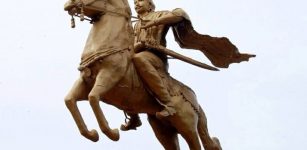 Powerful Chola Rulers Of Southern India: Patrons Of Architecture, Art And Literature
Civilizations | May 4, 2017
Powerful Chola Rulers Of Southern India: Patrons Of Architecture, Art And Literature
Civilizations | May 4, 2017 -
 Rare 1,400-Year-Old Temple Possibly Used By East Anglian Kings Discovered In Suffolk, UK
Archaeology | Nov 22, 2023
Rare 1,400-Year-Old Temple Possibly Used By East Anglian Kings Discovered In Suffolk, UK
Archaeology | Nov 22, 2023 -
 Book Of Kells: Illuminated Medieval Manuscript From Monastery On Iona, Scotland
Artifacts | Feb 8, 2018
Book Of Kells: Illuminated Medieval Manuscript From Monastery On Iona, Scotland
Artifacts | Feb 8, 2018 -
 Alkonost – Mythical Bird Of Paradise In Slavic And Russian Folklore
Featured Stories | Jul 6, 2020
Alkonost – Mythical Bird Of Paradise In Slavic And Russian Folklore
Featured Stories | Jul 6, 2020 -
 On This Day In History: First US Ship To Trade With China, ‘Empress Of China’ Sails From NY – On Feb 22, 1784
News | Feb 22, 2017
On This Day In History: First US Ship To Trade With China, ‘Empress Of China’ Sails From NY – On Feb 22, 1784
News | Feb 22, 2017 -
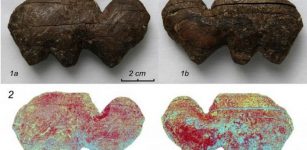 Ancient Mammoth Ivory Carving Technology Of Master Craftsmen – Reconstructed
Archaeology | Aug 27, 2020
Ancient Mammoth Ivory Carving Technology Of Master Craftsmen – Reconstructed
Archaeology | Aug 27, 2020 -
 A Stone Age Child Buried With Bird Feathers, Plant Fibers And Fur Investigated In Finland
Archaeology | Nov 2, 2022
A Stone Age Child Buried With Bird Feathers, Plant Fibers And Fur Investigated In Finland
Archaeology | Nov 2, 2022 -
 Menes – Legendary First Monarch Probably Under Different Names Who Unified Egypt
Featured Stories | Nov 7, 2016
Menes – Legendary First Monarch Probably Under Different Names Who Unified Egypt
Featured Stories | Nov 7, 2016

